Difference between revisions of "Moldy leather - Mouldy leather"
| Line 77: | Line 77: | ||
==Mould in the [[Leather production|manufacturing process]] of leather== | ==Mould in the [[Leather production|manufacturing process]] of leather== | ||
| − | + | Leather is not always [[leather production|produced]] from start till end in one [[tannery]]. Leather is sometimes first tanned in one tannery and then processed to [[Crust leather|crust]] at another location. This can lead to longer storage and transporting periods. A lot of leather is tanned in [https://www.youtube.com/watch?v=LDmkdFwqTt8&list=PLdGEmp0I4Bawry89Il_c1uc1F7M0Tr7sx South America] and then [[leather colour|dyed]] and [[finish|finished]] in Europe (mostly Italy). | |
| − | + | This long storage and transportation times may lead to mould growth. To reduce this risk, the leathers are treated with fungicides. The effectiveness is tested in climate chambers. When [[leather quality|testing the leathe]] for mould, it is stored at 30°C and 95-98% humidity. Then about 20 different mould spores are introduced into the chamber. Untreated leather suffers significantly after one week. The mold test is passed, if the leather persists without infestation for at least 4 weeks. | |
| − | == | + | ==Mould remediation in the use of leather== |
| − | + | Whether mould can be eliminated just by [[leather cleaner|cleaning]] it, or whether replacement of the cushioning material is needed, it cannot be answered generically as it depends on the duration of the exposure of the leather to the unfavourable environmental conditions that caused the mould to appear. Visible mould can usually still be removed, but the mouldy smell is the main problem. | |
| + | |||
| + | Mould that emerges after a few months is usually removed with diligent cleaning. Cases in which the mould has been spreading for over several years (wrong stored [[Vintage & Classic car leather|classic cars]], can rarely be just cleaned. The reason is the inner core of the upholstery. In such cases, the entire interior (foams, fabrics, cotton, etc.) has been infected by germs and mould spores. Such heavy infestation can be recognised, as it will not reduce the unpleasent smell despite a thorough cleaning of the surface. | ||
| − | |||
| Line 93: | Line 94: | ||
</p> | </p> | ||
<p align=center> | <p align=center> | ||
| − | '' | + | ''This [[car leather#Porsche|Porsche]] convertible was parked in an underground car park after an open drive in the rain. The mould was on all leather surfaces.''<br></p> |
<p> </p> | <p> </p> | ||
| Line 101: | Line 102: | ||
</p> | </p> | ||
<p align=center> | <p align=center> | ||
| − | '' | + | ''A mould infested [[Vintage & Classic car leather|classic car]] seat. - A [[Leather steering wheel|steering wheel]] with strong mildew.''<br></p> |
<p> </p> | <p> </p> | ||
| Line 109: | Line 110: | ||
</p> | </p> | ||
<p align=center> | <p align=center> | ||
| − | '' | + | ''[[Car leather#Volkswagen|Beetle]] Convertible. - Porsche in [https://www.youtube.com/watch?v=nbzBv0P5PdI Lissabon - Portugal]''<br></p> |
<p> </p> | <p> </p> | ||
Revision as of 21:37, 9 December 2016
Contents
Mould on leather
Some leather get mouldy or take on an unpleasant odour. Most often the cause of mould is incorrect storage of the leather.
Ideally, leather should be stored at room temperature and a humidity of 40-60%, taking care to ensure adequate air circulation. Constant humidity of more than 70%, high ambient temperature and lack of air circulation will contribute to the growth of fungi and bacteria immensely.
Also, the pH value plays an important role in creating an optimal environment for the growth of mould. Leather has a pH of about 4.5 to 5.5, putting it in the acidic range.
The viability of moulds as a function of pH is shown in the table below:
| Fungal species | Minimum | Optimum | Maximum |
|---|---|---|---|
| Alternaria | 2.7 | 5.4 | 8.0 |
| Aspergillus niger | 1.5 | 7.2 | 9.8 |
| Aspergillus flavus | 2.5 | 7.5 | 10.5 |
| Cladosporium herbarum | 3.1 | 7.7 | |
| Fusarium | 2.0 | 9.0 | |
| Penicillium | 2.0 | 10.0 | |
| Rhizopus stolonifer | 2.5 | 6.8 |
The optimum pH value varies depending on the fungal species. In principle, the pH of leather is good for the apparition of mould. Changing the pH of the leather would prevent mould, but it would also damage the leather or allow it to age faster.
The pH alone does not cause mould. Appropriate temperatures, suitable humidity and no ventilation create the environment for mould. It is therefore sufficient to take care of the other parameters, to prevent mould without altering the pH. Usually, even parking a car outdoors in various weather conditions without ventilation does not create mould. Mould therefore arises only in adverse situations. Most extreme humidity or improper storage, unless the vehicle is moved, this is most frequent when stored in damp sheds or garages.
Mould in the manufacturing process of leather
Leather is not always produced from start till end in one tannery. Leather is sometimes first tanned in one tannery and then processed to crust at another location. This can lead to longer storage and transporting periods. A lot of leather is tanned in South America and then dyed and finished in Europe (mostly Italy).
This long storage and transportation times may lead to mould growth. To reduce this risk, the leathers are treated with fungicides. The effectiveness is tested in climate chambers. When testing the leathe for mould, it is stored at 30°C and 95-98% humidity. Then about 20 different mould spores are introduced into the chamber. Untreated leather suffers significantly after one week. The mold test is passed, if the leather persists without infestation for at least 4 weeks.
Mould remediation in the use of leather
Whether mould can be eliminated just by cleaning it, or whether replacement of the cushioning material is needed, it cannot be answered generically as it depends on the duration of the exposure of the leather to the unfavourable environmental conditions that caused the mould to appear. Visible mould can usually still be removed, but the mouldy smell is the main problem.
Mould that emerges after a few months is usually removed with diligent cleaning. Cases in which the mould has been spreading for over several years (wrong stored classic cars, can rarely be just cleaned. The reason is the inner core of the upholstery. In such cases, the entire interior (foams, fabrics, cotton, etc.) has been infected by germs and mould spores. Such heavy infestation can be recognised, as it will not reduce the unpleasent smell despite a thorough cleaning of the surface.
This Porsche convertible was parked in an underground car park after an open drive in the rain. The mould was on all leather surfaces.
A mould infested classic car seat. - A steering wheel with strong mildew.
Beetle Convertible. - Porsche in Lissabon - Portugal
Selbst nach einer intensiven Außenbearbeitung verursacht jede Belastung der Polster, wie das Daraufsetzen, die Wirkung eines Blasebalgs: Die Schimmelsporen werden samt unangenehmem Geruch in den Innenraum geblasen. Es ist dann auch keine Lösung, zu versuchen, den Geruch mit anderen Gerüchen zu überlagern. Man erhält dann nur eine Mischung aus dem verwendeten Parfüm und dem Schimmelgeruch. Die Nase ist dann noch irritierter. Derart schwere Fälle lassen sich nur lösen, indem Polsterkern und Leder durch einen Sattler komplett ausgetauscht werden. Der Polsterkern kann in diesem Fall auch nicht befriedigend gewaschen oder wiederverwertet werden, was finanziell ohnehin keinen Vorteil verspräche: Das Leder ist dann bereits abgezogen, und ein neuer Polsterkern treibt die Kosten kaum noch in die Höhe, sondern verbessert den Sitzkomfort sogar meist erheblich. Ein weiteres Argument für neue Aufpolsterung ist zudem der Gesundheitsaspekt: Durch das Einatmen der Schimmelsporen und die Einwirkung der von ihnen abgegebenen Gifte können insbesondere Kinder und Menschen mit schwachem Immunsystem erkranken.
Bei Tests wurden Anti-Schimmel-Mittel geprüft. Dabei schnitten z. B. Isopropylalkohol und Essig-Essenz sehr gut ab. Isopropylalkohol kommt für Leder aber nicht in Frage. Die meisten Leder sind oberflächengefärbt, und diese Farbschichten werden durch Isopropylalkohol angelöst. Auch bei vorsichtiger Anwendung ist davon abzuraten. Essig-Essenz (pH-Wert ca. 2,0) tötet den Schimmel auch, hat aber einen angenehmen pH-Wert für Schimmel. Wie oben beschrieben, braucht man da aber keine Sorge zu haben. Bei ansonsten „normaler“ Verwendung oder Lagerung von Leder kommt es trotz schimmelfreundlichen pH-Werts nicht zu einer gesteigerten Empfindlichkeit. Leder ist immer im pH-Bereich, wo Schimmel sich wohl fühlt. Aber das führt nicht automatisch zur Schimmelbildung, wenn nicht weitere, fördernde Konstellationen die Basis für Schimmel schaffen.
Verschimmelte Tasche aus Containerlieferung - Möbel im Keller gelagert''
Verschimmelte Jacke und Möbel -> Alle beim Containertransport verschimmelt.
Verschimmelte Motorradkombi durch falsche Lagerung im feuchten Keller.
Verschimmelte Möbel aus Anilinleder nach Kellerlagerung.
Schwarzer Schimmel im Leder
Schwarzer Schimmel ist viel seltener bei Leder. Häufiger sind solche Stockflecken eher bei Kunstleder auf Booten oder beim Dachhimmel von Fahrzeugen. Die Flecken vom schwarzen Schimmel wachsen im Material und lassen sich durch eine Reinigung kaum entfernen. Selbst bei Versuchen, sie überzufärben, wandern sie oft durch die Farbe wieder zurück. Daher ist bei vielen Flecken der Neubezug die richtige Empfehlung und bei Färbungen eine Vorbehandlung mit einem Blocker notwendig.
Schwarzer Schimmel sitzt im Material und nicht wie der weiße Schimmel auf dem Material. Eine Reinigung funktioniert dann nicht.
Schimmelbehandlung
Bei weißem Schimmel und nicht zu langer Wartezeit, stehen die Chancen auf eine erfolgreiche Reinigung relativ gut. In diesem Fall wurde die Lüftung in einer Garage umgebaut, was zu einer Erhöhung der Luftfeuchtigkeit führte. Die Zeit bis zum Zustand auf den Fotos betrug maximal 5 Monate. Der Schimmel war auf allen weichen Oberflächen inkl. Gurte und Soft Lack der Kunststoffteile. Die Reinigung war eine Fleißarbeit, aber nicht kompliziert. Der Schimmelgeruch war trotz der Optik zu Beginn nicht stark und nach der Bearbeitung nicht mehr wahrnehmbar.
Gründliche Fleißarbeit von www.GlanzMobil.de und Glück für den Besitzer führte zu einer Rettung.
12px -> Tipp vom Lederzentrum: Die Arbeitsschritte bei der Entfernung von Schimmel auf Leder und Kunstleder
Fettausschlag
Achtung allerdings: Nicht immer sind weißliche Beläge auf der Lederoberfläche sofort und zweifelsfrei als Schimmel identifizierbar. Ein bekanntes Phänomen, das Schimmelbefall optisch sehr ähnelt, ist der Fettausschlag. Als Fettausschlag bezeichnet man weißlich austretende, überschüssige Fette. Diese Optik wird häufig mit Schimmel verwechselt. Vor jeglicher Behandlung muss daher eine Differenzierung erfolgen, womit man es genau zu tun hat. Kennzeichen von Fettausschlag ist, dass der Belag bei vorsichtiger Erwärmung des Leders mit einem Haartrockner verschwindet (da das Fett schmilzt) - was bei Schimmel nicht der Fall ist.
Fettausschlag ist kein Schimmel, auch wenn es so aussieht!
Weitere Lederschäden
- Typical leather damages such as aging, fading, grease stains, discolouration etc.
- Dye transfer from leather
- Typical damage to PU leather in the furniture area
- Flamingo effect: Reddish discolouration with light furniture leather in hidden areas
- Bronzing: Metallic glimmer on new leather
- The transmigration of adhesives from the back of the leather on the front
- Fatty spue - Fat marks on leather
Additional information
Further information on mold treatment
![]() -> COLOURLOCK - THE TREATMENT OF MOLDY LEATHER
-> COLOURLOCK - THE TREATMENT OF MOLDY LEATHER
![]() -> In German: www.lederzentrum.de
-> In German: www.lederzentrum.de
![]() -> Rest of the world: partners worldwide
-> Rest of the world: partners worldwide









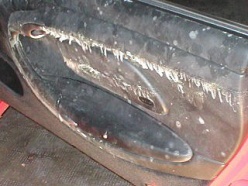
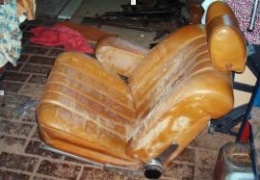




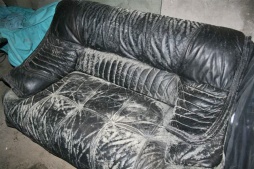


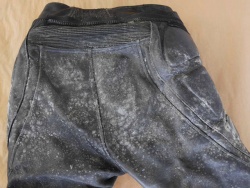



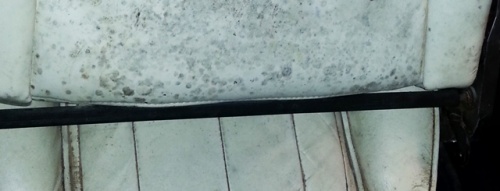

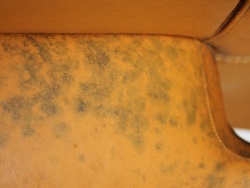







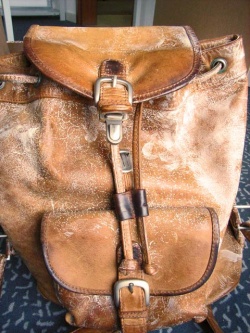
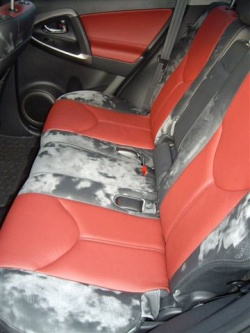

 a kotori web solution
a kotori web solution